Functional Analysis of the Ribosomal uL6 Protein of Saccharomyces cerevisiae
Abstract
1. Introduction
2. Materials and Methods
2.1. Strains, Plasmid Construction and Cell Growth
2.2. Protein Structure Prediction
2.3. Yeast Polysome Profile Analysis
2.4. Determination of Budding Lifespan
2.5. Determination of Total Lifespan
2.6. Cell Budding Ability and Viability of GAL::uL6A Strain
2.7. Statistical Analysis
3. Results
3.1. Depletion of uL6 Isoforms is not Lethal for Yeast Cells
3.2. Depletion of uL6A or B Isoforms Reduces Global Translation
3.3. Lack of uL6A or uL6B Inhibits Ribosome Biogenesis
3.4. Expression of uL6A or uL6B in Δul6A and Δul6B Mutants Restores the Translational Machinery Performance
3.5. Deletion of uL6A or uL6B Affects the Budding Lifespan and the Total Lifespan of Yeast
4. Discussion
Author Contributions
Funding
Conflicts of Interest
References
- Schmeing, T.M.; Ramakrishnan, V. What recent ribosome structures have revealed about the mechanism of translation. Nature 2009, 461, 1234–1242. [Google Scholar] [CrossRef] [PubMed]
- Voorhees, R.M.; Ramakrishnan, V. Structural Basis of the Translational Elongation Cycle. Annu. Rev. Biochem. 2013, 82, 203–236. [Google Scholar] [CrossRef] [PubMed]
- Diaconu, M.; Kothe, U.; Schlunzen, F.; Fischer, N.; Harms, J.M.; Tonevitsky, A.G.; Stark, H.; Rodnina, M.V.; Wahl, M.C. Structural basis for the function of the ribosomal L7/12 stalk in factor binding and GTPase activation. Cell 2005, 121, 991–1004. [Google Scholar] [CrossRef] [PubMed]
- Liljas, A.; Ehrenberg, M. Structural Aspects of Protein Synthesis, 2nd ed.; World Scientific Publishing Co. Pte. Ltd.: Singapore, 2013; pp. 1–438. [Google Scholar]
- Tissieres, A. Ribosome Research: Historical Background; Cold Spring Harbor Laboratory: New York, NY, USA, 1974; pp. 3–12. [Google Scholar]
- Woolford, J.L.; Baserga, S.J. Ribosome Biogenesis in the Yeast Saccharomyces cerevisiae. Genetics 2013, 195, 643–681. [Google Scholar] [CrossRef] [PubMed]
- Xue, S.F.; Barna, M. Specialized ribosomes: A new frontier in gene regulation and organismal biology. Nat. Rev. Mol. Cell Biol. 2012, 13, 355–369. [Google Scholar] [CrossRef] [PubMed]
- Planta, R.J.; Mager, W.H. The list of cytoplasmic ribosomal proteins of Saccharomyces cerevisiae. Yeast 1998, 14, 471–477. [Google Scholar] [CrossRef]
- Steffen, K.K.; McCormick, M.A.; Pham, K.M.; MacKay, V.L.; Delaney, J.R.; Murakami, C.J.; Kaeberlein, M.; Kennedy, B.K. Ribosome Deficiency Protects Against ER Stress in Saccharomyces cerevisiae. Genetics 2012, 191, 107–118. [Google Scholar] [CrossRef] [PubMed]
- Wolfe, K.H.; Shields, D.C. Molecular evidence for an ancient duplication of the entire yeast genome. Nature 1997, 387, 708–713. [Google Scholar] [CrossRef]
- Kellis, M.; Birren, B.W.; Lander, E.S. Proof and evolutionary analysis of ancient genome duplication in the yeast Saccharomyces cerevisiae. Nature 2004, 428, 617–624. [Google Scholar] [CrossRef]
- Dean, E.J.; Davis, J.C.; Davis, R.W.; Petrov, D.A. Pervasive and Persistent Redundancy among Duplicated Genes in Yeast. PLoS Genet. 2008. [Google Scholar] [CrossRef]
- Komili, S.; Farny, N.G.; Roth, F.P.; Silver, P.A. Functional specificity among ribosomal proteins regulates gene expression. Cell 2007, 131, 557–571. [Google Scholar] [CrossRef]
- Parenteau, J.; Lavoie, M.; Catala, M.; Malik-Ghulam, M.; Gagnon, J.; Abou Elela, S. Preservation of Gene Duplication Increases the Regulatory Spectrum of Ribosomal Protein Genes and Enhances Growth under Stress. Cell Rep. 2015, 13, 2516–2526. [Google Scholar] [CrossRef] [PubMed]
- Force, A.; Lynch, M.; Pickett, F.B.; Amores, A.; Yan, Y.L.; Postlethwait, J. Preservation of duplicate genes by complementary, degenerative mutations. Genetics 1999, 151, 1531–1545. [Google Scholar] [PubMed]
- Diss, G.; Gagnon-Arsenault, I.; Dion-Cote, A.M.; Vignaud, H.; Ascencio, D.I.; Berger, C.M.; Landry, C.R. Gene duplication can impart fragility, not robustness, in the yeast protein interaction network. Science 2017, 355, 630–633. [Google Scholar] [CrossRef] [PubMed]
- Gilbert, W.V. Functional specialization of ribosomes? Trends Biochem. Sci. 2011, 36, 127–132. [Google Scholar] [CrossRef] [PubMed]
- Filipovska, A.; Rackham, O. Specialization from synthesis: How ribosome diversity can customize protein function. FEBS Lett. 2013, 587, 1189–1197. [Google Scholar] [CrossRef]
- Shi, Z.; Barna, M. Trransiating the Genome in Time and Space: Specialized Ribosomes, RNA. Regulons, and RNA-Binding Proteins. Annu. Rev. Cell Dev. Biol. 2015, 31, 31–54. [Google Scholar] [CrossRef]
- Dinman, J.D. Pathways to Specialized Ribosomes: The Brussels Lecture. J. Mol. Biol. 2016, 428, 2186–2194. [Google Scholar] [CrossRef]
- Evans, D.S.; Kapahi, P.; Hsueh, W.C.; Kockel, L. TOR signaling never gets old: Aging, longevity and TORC1 activity. Ageing Res. Rev. 2011, 10, 225–237. [Google Scholar] [CrossRef]
- Fontana, L.; Partridge, L.; Longo, V.D. Extending Healthy Life Span-From Yeast to Humans. Science 2010, 328, 321–326. [Google Scholar] [CrossRef]
- Hansen, M.; Taubert, S.; Crawford, D.; Libina, N.; Lee, S.J.; Kenyon, C. Lifespan extension by conditions that inhibit translation in Caenorhabditis elegans. Aging Cell 2007, 6, 95–110. [Google Scholar] [CrossRef] [PubMed]
- Kapahi, P.; Zid, B.M.; Harper, T.; Koslover, D.; Sapin, V.; Benzer, S. Regulation of lifespan in Drosophila by modulation of genes in the TOR signaling pathway. Curr. Biol. 2004, 14, 885–890. [Google Scholar] [CrossRef] [PubMed]
- Zid, B.M.; Rogers, A.N.; Katewa, S.D.; Vargas, M.A.; Kolipinski, M.C.; Lu, T.A.; Benzer, S.; Kapahi, P. 4E-BP Extends Lifespan upon Dietary Restriction by Enhancing Mitochondrial Activity in Drosophila. Cell 2009, 139, 149–160. [Google Scholar] [CrossRef] [PubMed]
- Rogers, A.N.; Chen, D.; McColl, G.; Czerwieniec, G.; Felkey, K.; Gibson, B.W.; Hubbard, A.; Melov, S.; Lithgow, G.J.; Kapahi, P. Life Span Extension via eIF4G Inhibition Is Mediated by Posttranscriptional Remodeling of Stress Response Gene Expression in C. elegans. Cell Metab. 2011, 14, 55–66. [Google Scholar] [CrossRef] [PubMed]
- Steffen, K.K.; MacKay, V.L.; Kerr, E.O.; Tsuchiya, M.; Hu, D.; Fox, L.A.; Dang, N.; Johnston, E.D.; Oakes, J.A.; Tchao, B.N.; et al. Yeast life span extension by depletion of 60S ribosomal subunits is mediated by Gcn4. Cell 2008, 133, 292–302. [Google Scholar] [CrossRef] [PubMed]
- Molon, M.; Zadrag-Tecza, R.; Bilinski, T. The longevity in the yeast Saccharomyces cerevisiae: A comparison of two approaches for assessment the lifespan. Biochem. Biophys. Res. Commun. 2015, 460, 651–656. [Google Scholar] [CrossRef] [PubMed]
- Ban, N.; Beckmann, R.; Cate, J.H.D.; Dinman, J.D.; Dragon, F.; Ellis, S.R.; Lafontaine, D.L.J.; Lindahl, L.; Liljas, A.; Lipton, J.M.; et al. A new system for naming ribosomal proteins. Curr. Opin. Struct. Biol. 2014, 24, 165–169. [Google Scholar] [CrossRef] [PubMed]
- Shigeno, Y.; Uchiumi, T.; Nomura, T. Involvement of ribosomal protein L6 in assembly of functional 50S ribosomal subunit in Escherichia coli cells. Biochem. Biophys. Res. Commun. 2016, 473, 237–242. [Google Scholar] [CrossRef]
- Schmidt, A.; Hollmann, M.; Schafer, U. A newly identified Minute locus, M(2)32D, encodes the ribosomal protein L9 in Drosophila melanogaster. Mol. Gen. Genet. 1996, 251, 381–387. [Google Scholar]
- MacInnes, A.W.; Amsterdam, A.; Whittaker, C.A.; Hopkins, N.; Lees, J.A. Loss of p53 synthesis in zebrafish tumors with ribosomal protein gene mutations. Proc. Natl. Acad. Sci. USA 2008, 105, 10408–10413. [Google Scholar] [CrossRef] [PubMed]
- Beyer, A.R.; Bann, D.V.; Rice, B.; Pultz, I.S.; Kane, M.; Goff, S.P.; Golovkina, T.V.; Parent, L.J. Nucleolar Trafficking of the Mouse Mammary Tumor Virus Gag Protein Induced by Interaction with Ribosomal Protein L9. J. Virol. 2013, 87, 1069–1082. [Google Scholar] [CrossRef] [PubMed]
- Gudipati, R.K.; Neil, H.; Feuerbach, F.; Malabat, C.; Jacquier, A. The yeast RPL9B gene is regulated by modulation between two modes of transcription termination. Embo J. 2012, 31, 2427–2437. [Google Scholar] [CrossRef] [PubMed]
- Wach, A.; Brachat, A.; Rebischung, C.; Steiner, S.; Pokorni, K.; te Heesen, S.; Philippsen, P. PCR-based gene targeting in Saccharomyces cerevisiae. Yeast Gene Anal. 1998, 26, 67–81. [Google Scholar]
- Thompson, J.D.; Gibson, T.J.; Plewniak, F.; Jeanmougin, F.; Higgins, D.G. The CLUSTAL_X windows interface: Flexible strategies for multiple sequence alignment aided by quality analysis tools. Nucleic Acids Res. 1997, 25, 4876–4882. [Google Scholar] [CrossRef] [PubMed]
- Molon, M.; Zebrowski, J. Phylogenetic relationship and Fourier-transform infrared spectroscopy-derived lipid determinants of lifespan parameters in the Saccharomyces cerevisiae yeast. FEMS Yeast Res. 2017, 17, fox031. [Google Scholar] [CrossRef]
- Minois, N.; Frajnt, M.; Wilson, C.; Vaupel, J.W. Advances in measuring lifespan in the yeast Saccharomyces cerevisiae. Proc. Natl. Acad. Sci. USA 2005, 102, 402–406. [Google Scholar] [CrossRef] [PubMed]
- Feng, S.; Chen, Y.; Gao, Y.G. Crystal Structure of 70S Ribosome with Both Cognate tRNAs in the E and P Sites Representing an Authentic Elongation Complex. PLoS ONE 2013, 8, e58829. [Google Scholar] [CrossRef]
- Gari, E.; Piedrafita, L.; Aldea, M.; Herrero, E. A set of vectors with a tetracycline-regulatable promoter system for modulated gene expression in Saccharomyces cerevisiae. Yeast 1997, 13, 837–848. [Google Scholar] [CrossRef]
- Zhang, Z.J.; Ren, Q. Why are essential genes essential? - The essentiality of Saccharomyces genes. Microb. Cell 2015, 2, 280–287. [Google Scholar] [CrossRef]
- Gerst, J.E. Pimp My Ribosome: Ribosomal Protein Paralogs Specify Translational Control. Trends Genet. 2018, 34, 832–845. [Google Scholar] [CrossRef]
- Poll, G.; Braun, T.; Jakovljevic, J.; Neueder, A.; Jakob, S.; Woolford, J.L.; Tschochner, H.; Milkereit, P. rRNA Maturation in Yeast Cells Depleted of Large Ribosomal Subunit Proteins. PLoS ONE 2009, 4. [Google Scholar] [CrossRef] [PubMed]
- Wawiorka, L.; Molestak, E.; Szajwaj, M.; Michalec-Wawiorka, B.; Boguszewska, A.; Borkiewicz, L.; Liudkovska, V.; Kufel, J.; Tchorzewski, M. Functional analysis of the uL11 protein impact on translational machinery. Cell Cycle 2016, 15, 1060–1072. [Google Scholar] [CrossRef] [PubMed]
- Liljas, A. uL11, a central player in translation. Cell Cycle 2016, 15, 1529–1530. [Google Scholar] [CrossRef] [PubMed][Green Version]
- Gamalinda, M.; Ohmayer, U.; Jakovljevic, J.; Kumcuoglu, B.; Woolford, J.; Mbom, B.; Lin, L.; Woolford, J.L. A hierarchical model for assembly of eukaryotic 60S ribosomal subunit domains. Genes Dev. 2014, 28, 198–210. [Google Scholar] [CrossRef] [PubMed]
- Wimberly, B.T.; Guymon, R.; McCutcheon, J.P.; White, S.W.; Ramakrishnan, V. A detailed view of a ribosomal active site: The structure of the L11-RNA complex. Cell 1999, 97, 491–502. [Google Scholar] [CrossRef]
- Uchiumi, T.; Sato, N.; Wada, A.; Hachimori, A. Interaction of the sarcin/ricin domain of 23 S ribosomal RNA with proteins L3 and L6. J. Biol. Chem. 1999, 274, 681–686. [Google Scholar] [CrossRef] [PubMed]
- Beauclerk, A.A.; Cundliffe, E.; Dijk, J. The binding site for ribosomal protein complex L8 within 23 s ribosomal RNA of Escherichia coli. J. Biol. Chem. 1984, 259, 6559–6563. [Google Scholar] [PubMed]
- Briones, E.; Briones, C.; Remacha, M.; Ballesta, J.P.G. The GTPase center protein L12 is required for correct ribosomal stalk assembly but not for Saccharomyces cerevisiae viability. J. Biol. Chem. 1998, 273, 31956–31961. [Google Scholar] [CrossRef]
- Papp, B.; Pal, C.; Hurst, L.D. Metabolic network analysis of the causes and evolution of enzyme dispensability in yeast. Nature 2004, 429, 661–664. [Google Scholar] [CrossRef]
- Sugino, R.P.; Innan, H. Natural Selection on Gene Order in the Genome Reorganization Process After Whole-Genome Duplication of Yeast. Mol. Biol. Evol. 2012, 29, 71–79. [Google Scholar] [CrossRef]
- Fraser, H.B.; Hirsh, A.E.; Giaever, G.; Kumm, J.; Eisen, M.B. Noise minimization in eukaryotic gene expression. PLoS Biol. 2004, 2, 834–838. [Google Scholar] [CrossRef] [PubMed]
- Raser, J.M.; O’Shea, E.K. Noise in gene expression: Origins, consequences, and control. Science 2005, 309, 2010–2013. [Google Scholar] [CrossRef] [PubMed]
- Chiocchetti, A.; Zhou, J.; Zhu, H.S.; Karl, T.; Haubenreisser, O.; Rinnerthaler, M.; Heeren, G.; Oender, K.; Bauer, J.; Hintner, H.; et al. Ribosomal proteins Rp110 and Rps6 are potent regulators of yeast replicative life span. Exp. Gerontol. 2007, 42, 275–286. [Google Scholar] [CrossRef] [PubMed]
- Managbanag, J.R.; Witten, T.M.; Bonchev, D.; Fox, L.A.; Tsuchiya, M.; Kennedy, B.K.; Kaeberlein, M. Shortest-Path Network Analysis Is a Useful Approach toward Identifying Genetic Determinants of Longevity. PLoS ONE 2008, 3, e3802. [Google Scholar] [CrossRef] [PubMed]
- Smith, E.D.; Tsuchiya, M.; Fox, L.A.; Dang, N.; Hu, D.; Kerr, E.O.; Johnston, E.D.; Tchao, B.N.; Pak, D.N.; Welton, K.L.; et al. Quantitative evidence for conserved longevity pathways between divergent eukaryotic species. Genome Res. 2008, 18, 564–570. [Google Scholar] [CrossRef] [PubMed]
- McCormick, M.A.; Delaney, J.R.; Tsuchiya, M.; Tsuchiyama, S.; Shemorry, A.; Sim, S.; Chou, A.C.Z.; Ahmed, U.; Carr, D.; Murakami, C.J.; et al. A Comprehensive Analysis of Replicative Lifespan in 4,698 Single-Gene Deletion Strains Uncovers Conserved Mechanisms of Aging. Cell Metab. 2015, 22, 895–906. [Google Scholar] [CrossRef] [PubMed]
- Molon, M.; Zadrag-Tecza, R. Effect of temperature on replicative aging of the budding yeast Saccharomyces cerevisiae. Biogerontology 2016, 17, 347–357. [Google Scholar] [CrossRef]
- Molon, M.; Szajwaj, M.; Tchorzewski, M.; Skoczowski, A.; Niewiadomska, E.; Zadrag-Tecza, R. The rate of metabolism as a factor determining longevity of the Saccharomyces cerevisiae yeast. Age 2016, 38, 11. [Google Scholar] [CrossRef]

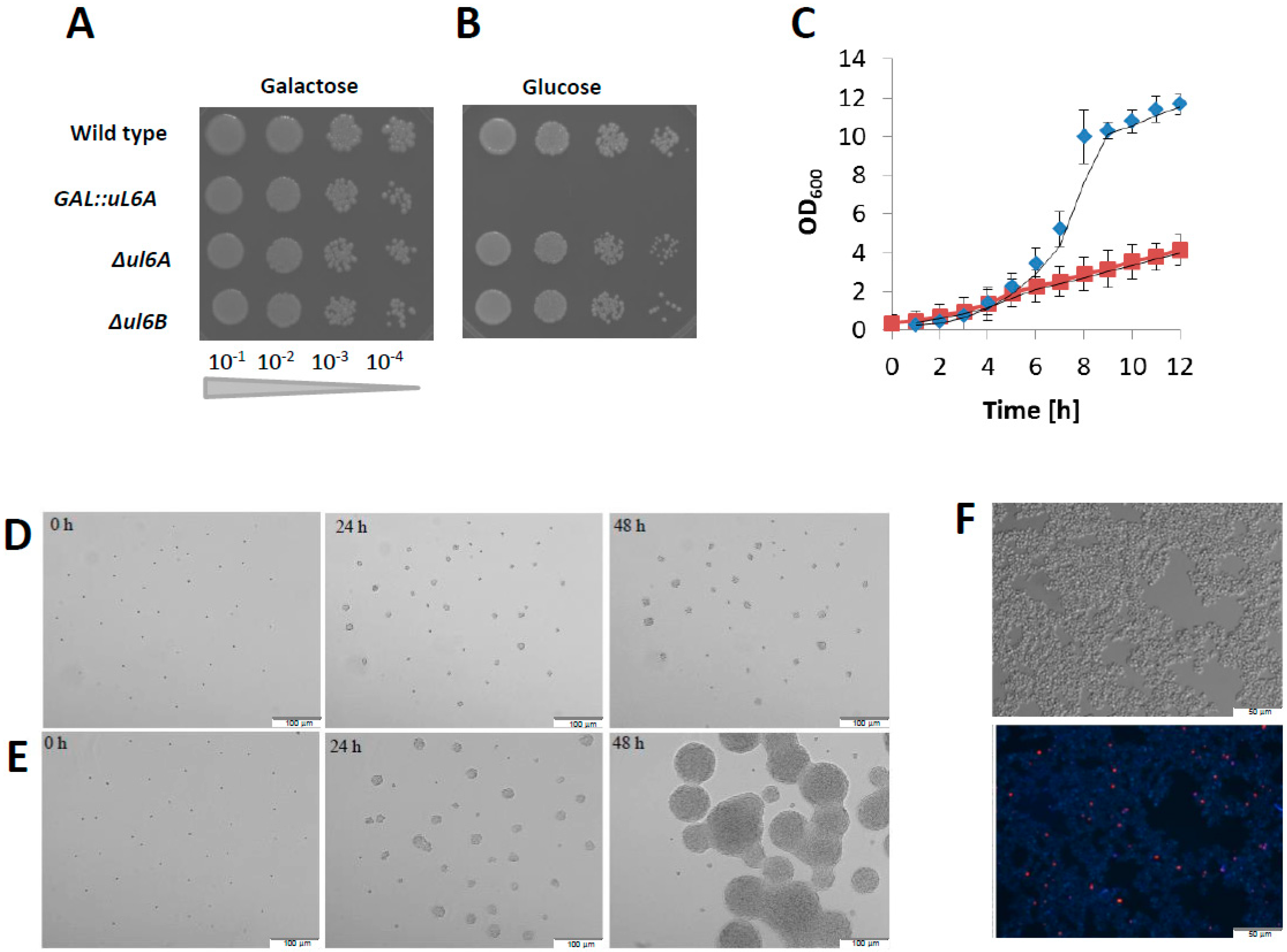
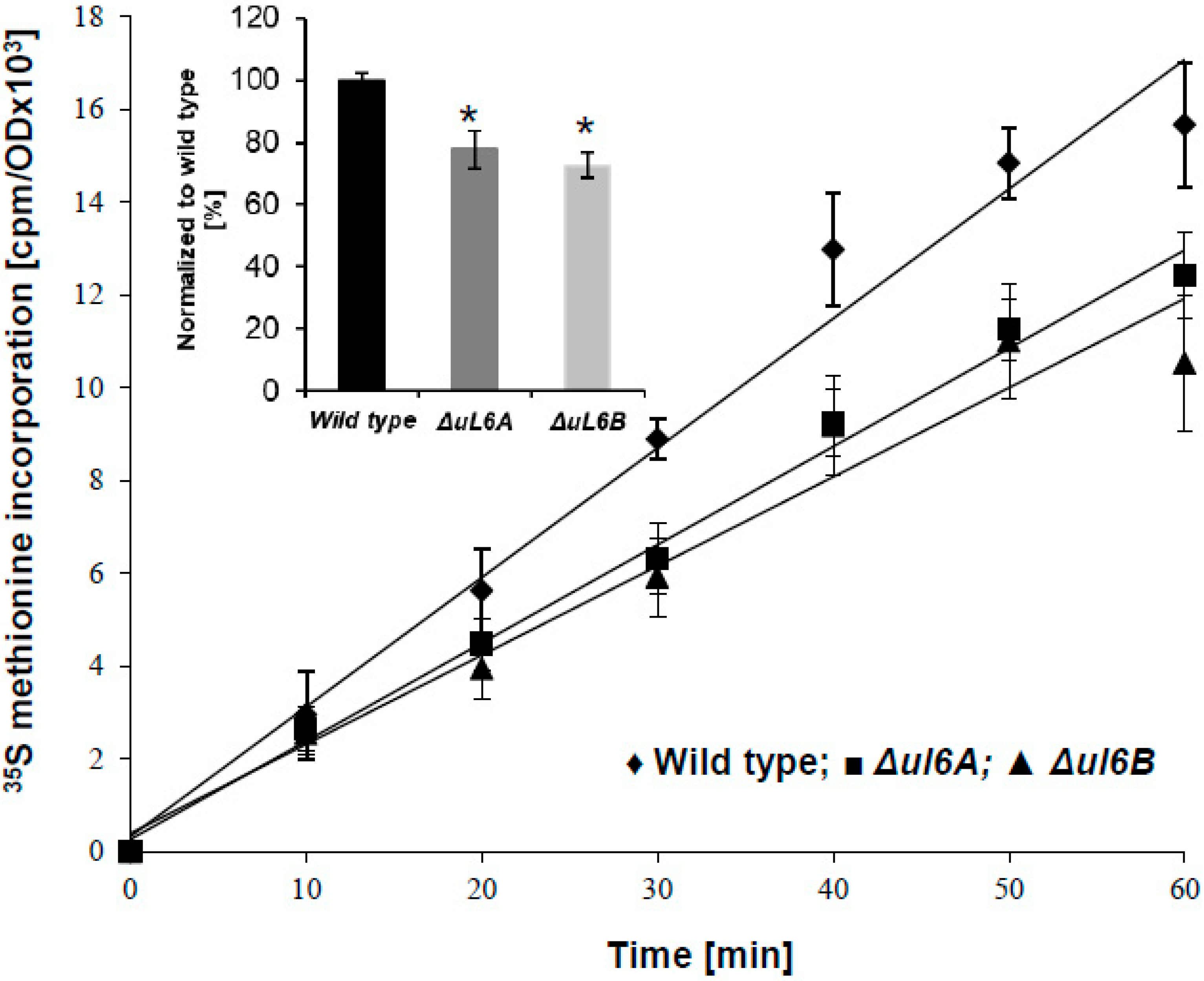
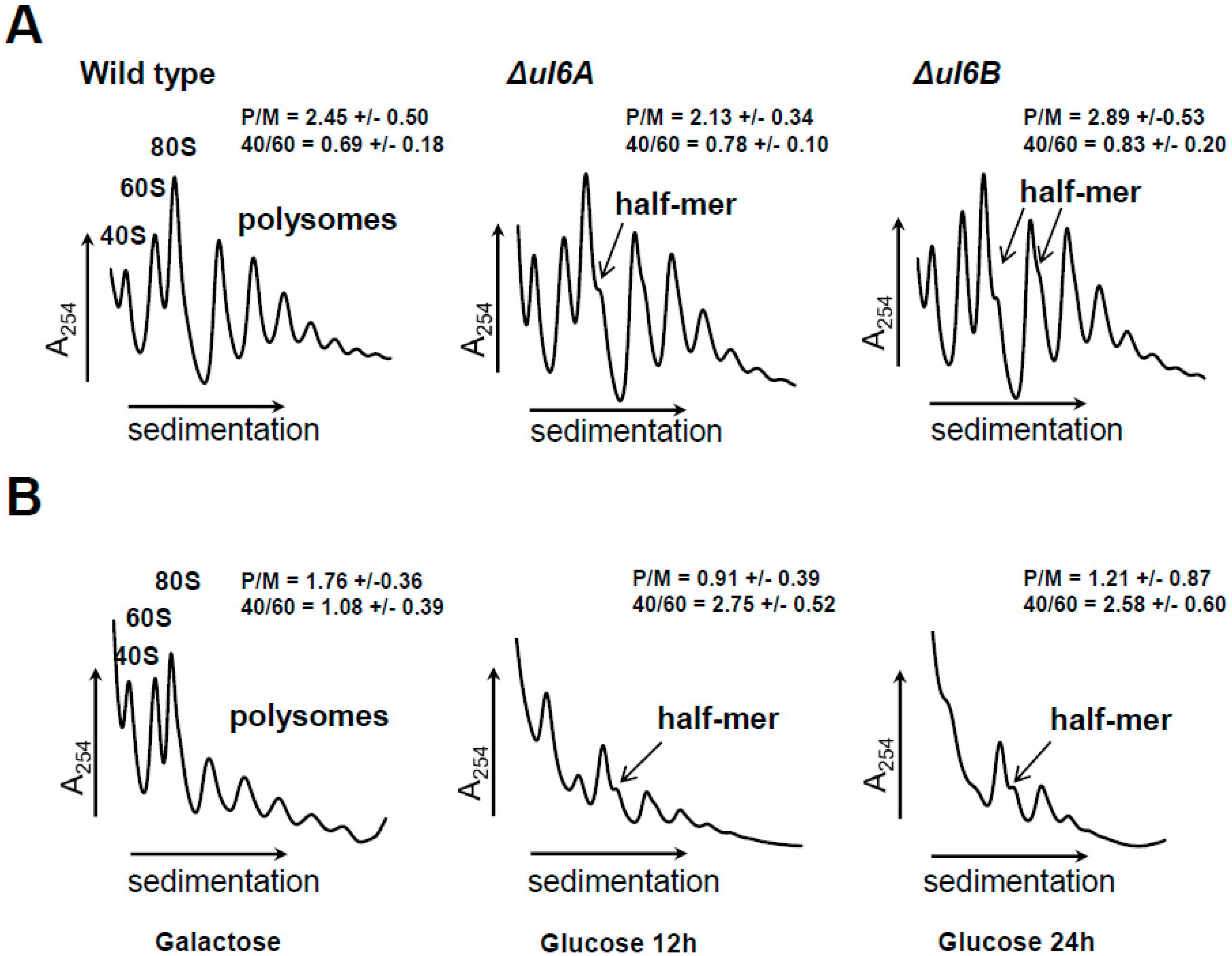
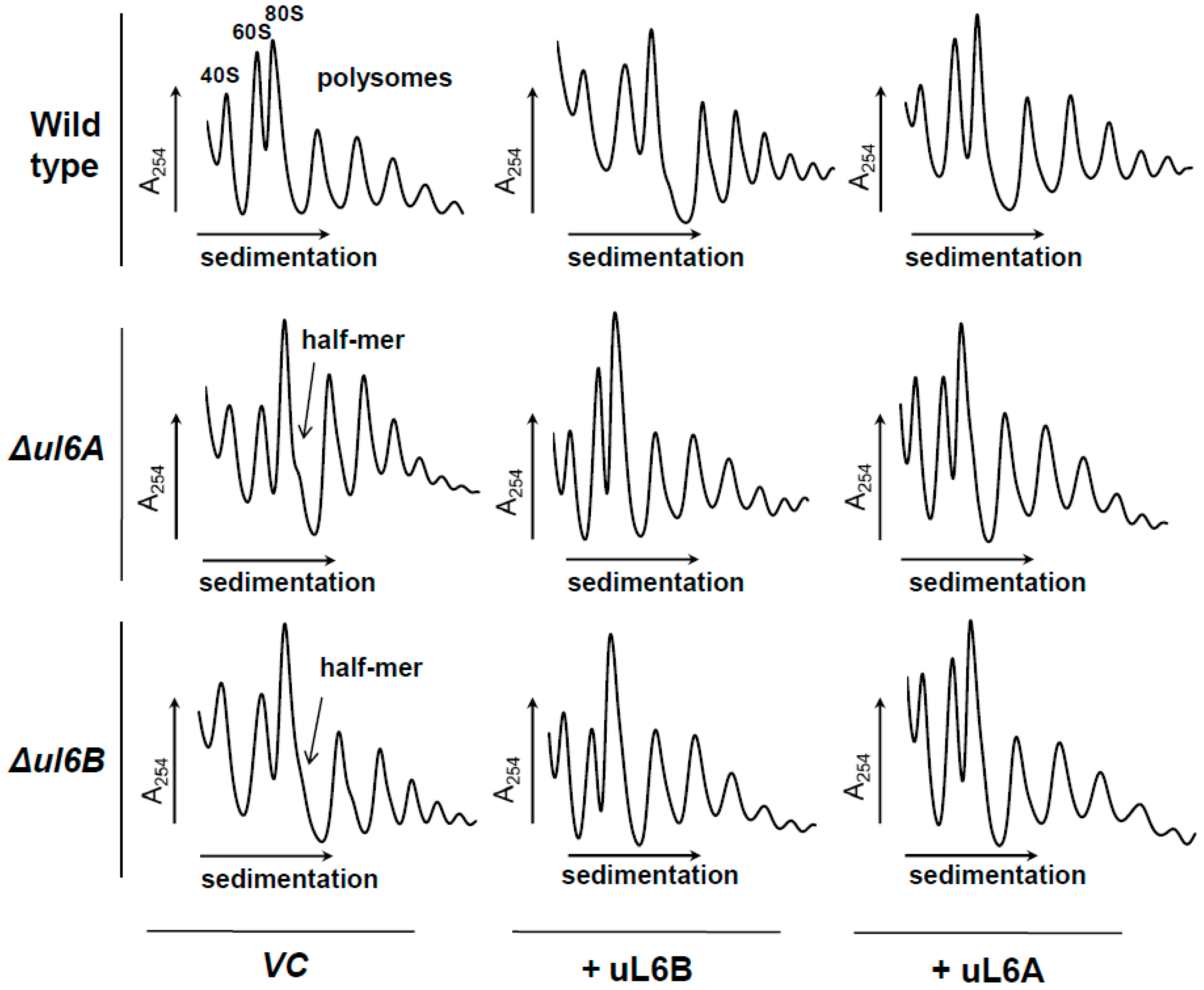
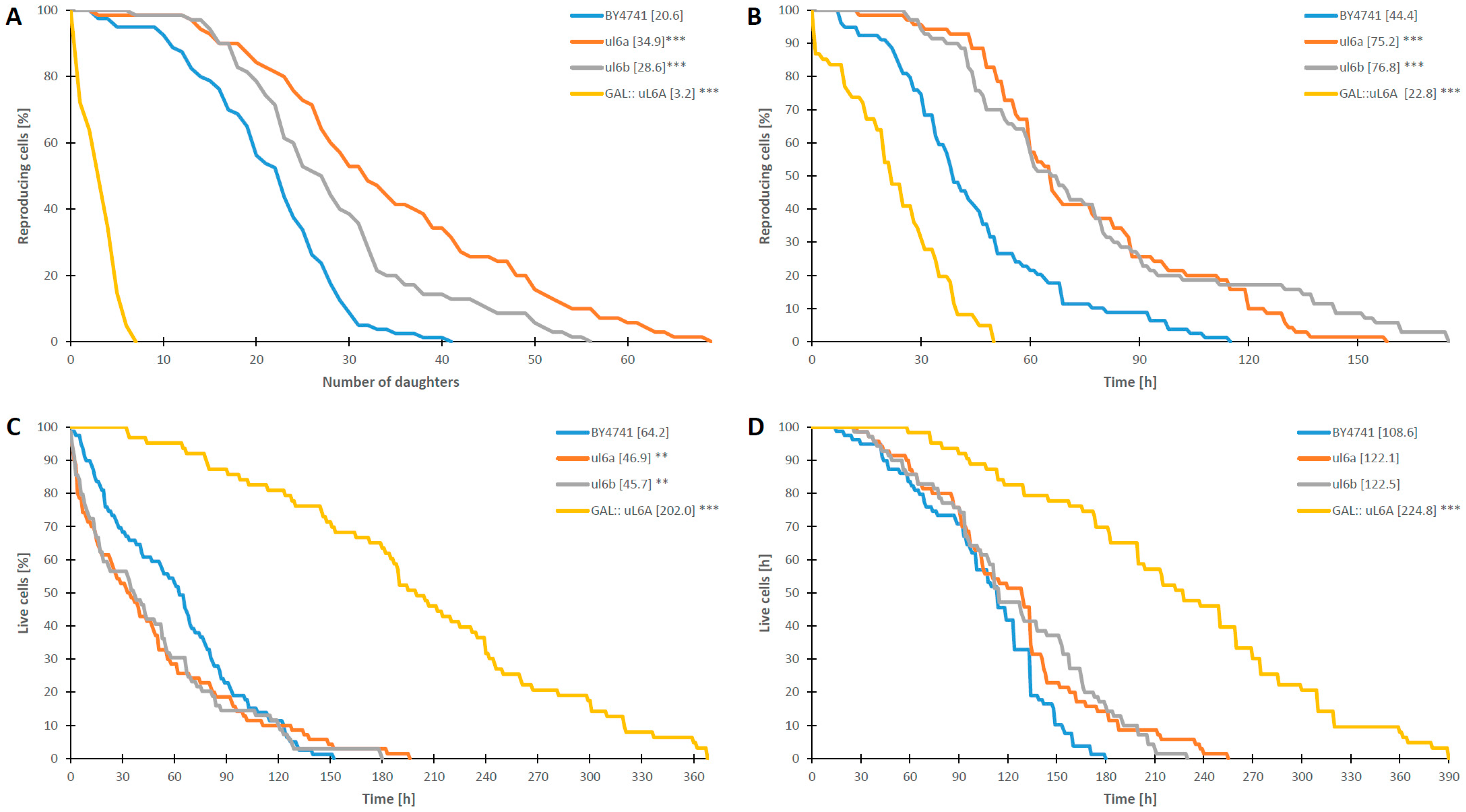
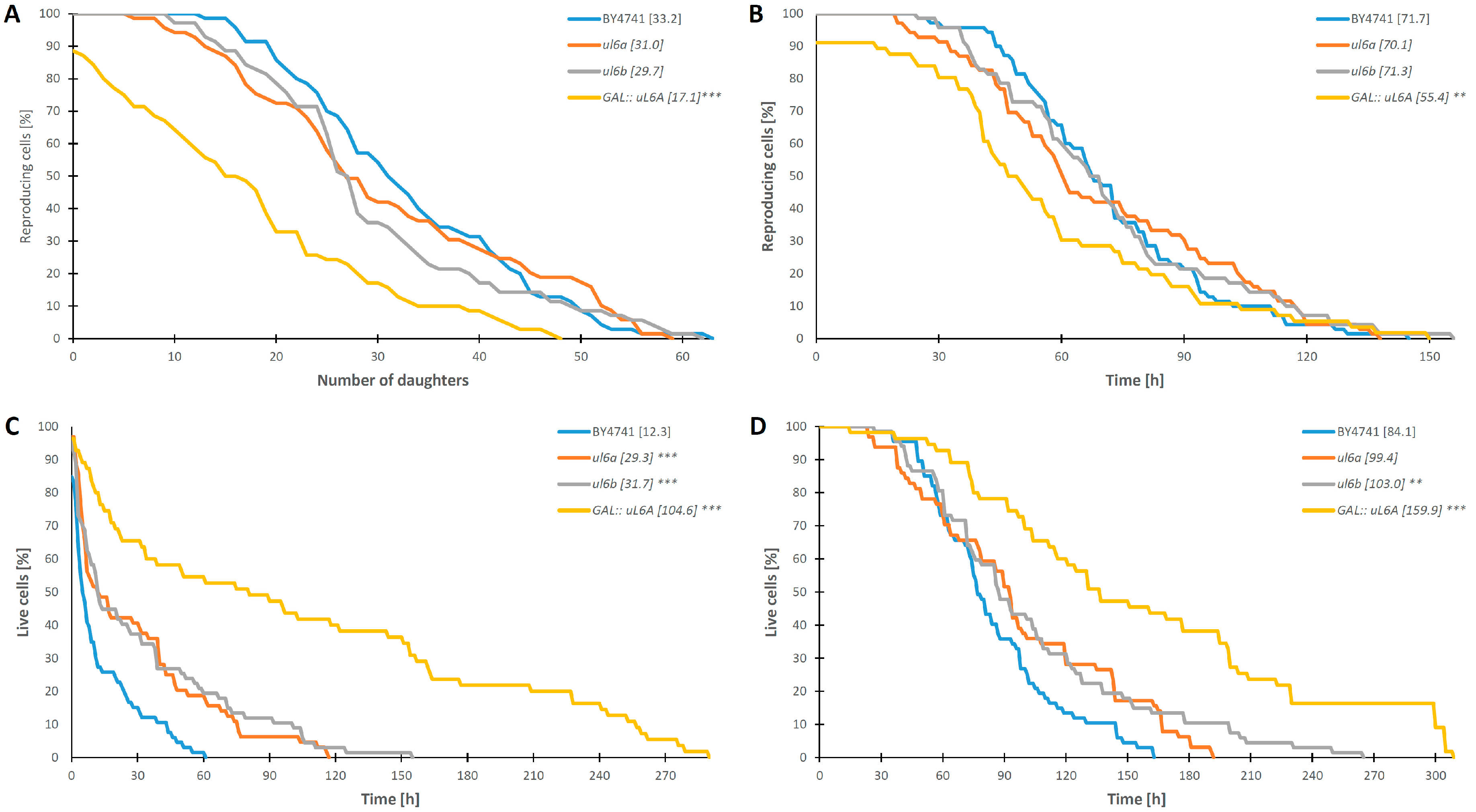
| Strain Name | Genotype | Source |
|---|---|---|
| BY4741 | MAT a; his3Δ1; leu2Δ0; met15Δ0; ura3Δ0 | EUROSCARF |
| Δul6A | MAT a; his3Δ1; leu2Δ0; met15Δ0; ura3Δ0; YGL147c::kanMX4 | EUROSCARF |
| Δul6B | MAT a; his3Δ1; leu2Δ0; met15Δ0; ura3Δ0; YNL067w::kanMX4 | EUROSCARF |
| GAL::uL6A | MAT a; his3Δ1; leu2Δ0; met15Δ0; ura3Δ0; YGL147c::kanMX4,YNL067w::LEU2 [pYES2-uL6A] | in this study |
| BY4741 VC | MAT a; his3Δ1; leu2Δ0; met15Δ0; ura3Δ0 [pCM190] | in this study |
| BY4741 + uL6A | BY4741; MAT a; his3Δ1; leu2Δ0; met15Δ0; ura3Δ0 [pCM190-uL6A] | in this study |
| BY4741 + uL6B | BY4741; MAT a; his3Δ1; leu2Δ0; met15Δ0; ura3Δ0 [pCM190-uL6B] | in this study |
| Δul6A VC | BY4741; MAT a; his3Δ1; leu2Δ0; met15Δ0; ura3Δ0; YGL147c::kanMX4 [pCM190] | in this study |
| Δul6A + uL6A | BY4741; MAT a; his3Δ1; leu2Δ0; met15Δ0; ura3Δ0; YGL147c::kanMX4 [pCM190-uL6A] | in this study |
| ΔuL6A + uL6B | BY4741; MAT a; his3Δ1; leu2Δ0; met15Δ0; ura3Δ0; YGL147c::kanMX4 [pCM190-uL6B] | in this study |
| ΔuL6B VC | BY4741; MAT a; his3Δ1; leu2Δ0; met15Δ0; ura3Δ0; YNL067w::kanMX4 [pCM190] | in this study |
| ΔuL6B + uL6A | BY4741; MAT a; his3Δ1; leu2Δ0; met15Δ0; ura3Δ0; YNL067w::kanMX4 [pCM190-uL6A] | in this study |
| ΔuL6B + uL6B | BY4741; MAT a; his3Δ1; leu2Δ0; met15Δ0; ura3Δ0; YNL067w::kanMX4 [pCM190-uL6B] | in this study |
© 2019 by the authors. Licensee MDPI, Basel, Switzerland. This article is an open access article distributed under the terms and conditions of the Creative Commons Attribution (CC BY) license (http://creativecommons.org/licenses/by/4.0/).
Share and Cite
Borkiewicz, L.; Mołoń, M.; Molestak, E.; Grela, P.; Horbowicz-Drożdżal, P.; Wawiórka, L.; Tchórzewski, M. Functional Analysis of the Ribosomal uL6 Protein of Saccharomyces cerevisiae. Cells 2019, 8, 718. https://doi.org/10.3390/cells8070718
Borkiewicz L, Mołoń M, Molestak E, Grela P, Horbowicz-Drożdżal P, Wawiórka L, Tchórzewski M. Functional Analysis of the Ribosomal uL6 Protein of Saccharomyces cerevisiae. Cells. 2019; 8(7):718. https://doi.org/10.3390/cells8070718
Chicago/Turabian StyleBorkiewicz, Lidia, Mateusz Mołoń, Eliza Molestak, Przemysław Grela, Patrycja Horbowicz-Drożdżal, Leszek Wawiórka, and Marek Tchórzewski. 2019. "Functional Analysis of the Ribosomal uL6 Protein of Saccharomyces cerevisiae" Cells 8, no. 7: 718. https://doi.org/10.3390/cells8070718
APA StyleBorkiewicz, L., Mołoń, M., Molestak, E., Grela, P., Horbowicz-Drożdżal, P., Wawiórka, L., & Tchórzewski, M. (2019). Functional Analysis of the Ribosomal uL6 Protein of Saccharomyces cerevisiae. Cells, 8(7), 718. https://doi.org/10.3390/cells8070718







